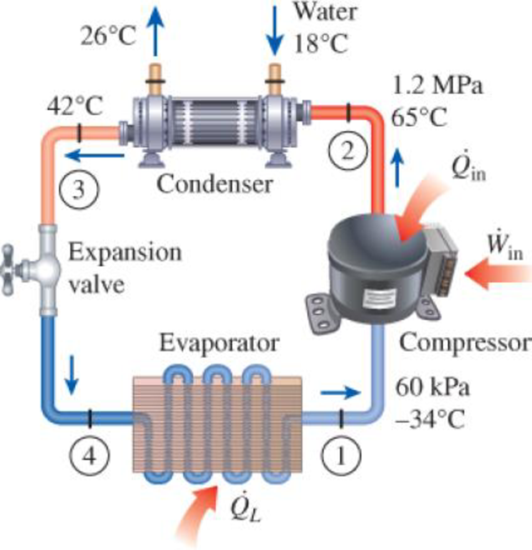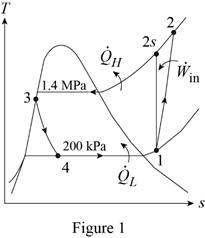
A commercial refrigerator with refrigerant-134a as the working fluid is used to keep the refrigerated space at −30°C by rejecting its waste heat to cooling water that enters the condenser at 18°C at a rate of 0.25 kg/s and leaves at 26°C. The refrigerant enters the condenser at 1.2 MPa and 65°C and leaves at 42°C. The inlet state of the compressor is 60 kPa and −34°C and the compressor is estimated to gain a net heat of 450 W from the surroundings. Determine (a) the quality of the refrigerant at the evaporator inlet, (b) the refrigeration load, (c) the COP of the refrigerator, and (d) the theoretical maximum refrigeration load for the same power input to the compressor.
FIGURE P11–22

(a)
The quality of the refrigerant at the evaporator inlet.
Answer to Problem 18P
The quality of the refrigerant at the evaporator inlet is
Explanation of Solution
Show the T-s diagram for the refrigeration cycle as in Figure (1).

Express specific enthalpy at state 3.
Here, specific enthalpy at saturated liquid and temperature of
Express the quality of the refrigerant at the evaporator inlet.
Here, specific enthalpy at saturated liquid and pressure of
Conclusion:
Perform unit conversion of pressure at state 1 from
Refer Table A-13, “superheated refrigerant-134a”, and write the value of specific enthalpy at state 1
Write the formula of interpolation method of two variables.
Here, the variables denote by x and y is initial temperature and specific enthalpy at state 1 respectively.
Show the specific enthalpy at state 2 corresponding to specific entropy as in Table (1).
|
Initial temperature |
Specific enthalpy at state 1 |
| 227.80 | |
| 240.78 |
Substitute
Perform unit conversion of pressure at state 2 from
Refer Table A-13, “superheated refrigerant-134a”, and write the value of specific enthalpy at state 2
Show the specific enthalpy at state 2 corresponding to temperature as in Table (2).
|
Temperature |
Specific enthalpy at state 2 |
| 289.66 | |
| 300.63 |
Use Excel by taking the values from Table (2), and using Equation (III) to get specific enthalpy at state 2.
Refer Table A-11, “saturated refrigerant 134a-temperature table”, and write the properties corresponding to temperature at state 3 of
Substitute
From Figure (1), write the specific enthalpy at state 3 is equal to state 4 due to throttling process.
Here, specific enthalpy at state 4 is
Refer Table A-12, “saturated refrigerant 134a-pressure table”, and write the properties corresponding to pressure at state 4 of
Substitute
Hence, the quality of the refrigerant at the evaporator inlet is
(b)
The refrigeration load.
Answer to Problem 18P
The refrigeration load is
Explanation of Solution
Express the mass flow rate of the refrigerant from an energy balance on the compressor.
Here, mass flow rate of the water is
Express the rate of heat supplied from the refrigerant.
Express compressor power input.
Here, rate of heat gained by compressor is
Express the refrigeration load.
Conclusion:
Refer Table A-4, “saturated water-temperature table”, and write the initial specific enthalpy of water corresponding to temperature of
Show the initial specific enthalpy of water corresponding to temperature as in Table (3).
|
Temperature |
Initial specific enthalpy of water |
| 15 | 62.982 |
| 18 | |
| 20 | 83.915 |
Use Excel by taking the values from Table (3), and using Equation (III) to get initial specific enthalpy of water.
Refer Table A-4, “saturated water-temperature table”, and write the initial specific enthalpy of water corresponding to temperature of
Show the initial specific enthalpy of water corresponding to temperature as in Table (3).
|
Temperature |
Final specific enthalpy of water |
| 25 | 104.83 |
| 26 | |
| 30 | 125.74 |
Use Excel by taking the values from Table (3), and using Equation (III) to get final specific enthalpy of water.
Substitute
Substitute
Substitute
Substitute
Hence, the refrigeration load is
(c)
The COP of the refrigerator.
Answer to Problem 18P
The COP of the refrigerator is
Explanation of Solution
Express the coefficient of performance of the refrigerator.
Conclusion:
Substitute
Hence, the coefficient of performance of the refrigerator is
(d)
The theoretical maximum refrigeration load.
Answer to Problem 18P
The theoretical maximum refrigeration load is
Explanation of Solution
Express the reversible COP of the refrigerator for the similar temperature limits.
Here, high and low source temperature is
Express the theoretical maximum refrigeration load.
Conclusion:
Substitute
Substitute
Hence, the theoretical maximum refrigeration load is
Want to see more full solutions like this?
Chapter 11 Solutions
Thermodynamics: An Engineering Approach
- (read me)arrow_forward(read image)arrow_forwardQu. 13 What are the indices for the Direction 2 indicated by vector in the following sketch? Qu. 14 Determine the indices for the direction A and B shown in the following cubic unit cell. please show all work step by step from material engineeringarrow_forward
- The thin-walled open cross section shown is transmitting torque 7. The angle of twist ₁ per unit length of each leg can be determined separately using the equation 01 = 3Ti GLIC 3 where G is the shear modulus, ₁ is the angle of twist per unit length, T is torque, and L is the length of the median line. In this case, i = 1, 2, 3, and T; represents the torque in leg i. Assuming that the angle of twist per unit length for each leg is the same, show that T= Lic³ and Tmaz = G01 Cmax Consider a steel section with Tallow = 12.40 kpsi. C1 2 mm L1 20 mm C2 3 mm L2 30 mm C3 2 mm L3 25 mm Determine the torque transmitted by each leg and the torque transmitted by the entire section. The torque transmitted by the first leg is | N-m. The torque transmitted by the second leg is N-m. The torque transmitted by the third leg is N-m. The torque transmitted by the entire section is N-m.arrow_forwardPlease help, make sure it's to box out and make it clear what answers go where...arrow_forwardThe cylinder floats in the water and oil to the level shown. Determine the weight of the cylinder. (rho)o=910 kg/m^3arrow_forward
 Elements Of ElectromagneticsMechanical EngineeringISBN:9780190698614Author:Sadiku, Matthew N. O.Publisher:Oxford University Press
Elements Of ElectromagneticsMechanical EngineeringISBN:9780190698614Author:Sadiku, Matthew N. O.Publisher:Oxford University Press Mechanics of Materials (10th Edition)Mechanical EngineeringISBN:9780134319650Author:Russell C. HibbelerPublisher:PEARSON
Mechanics of Materials (10th Edition)Mechanical EngineeringISBN:9780134319650Author:Russell C. HibbelerPublisher:PEARSON Thermodynamics: An Engineering ApproachMechanical EngineeringISBN:9781259822674Author:Yunus A. Cengel Dr., Michael A. BolesPublisher:McGraw-Hill Education
Thermodynamics: An Engineering ApproachMechanical EngineeringISBN:9781259822674Author:Yunus A. Cengel Dr., Michael A. BolesPublisher:McGraw-Hill Education Control Systems EngineeringMechanical EngineeringISBN:9781118170519Author:Norman S. NisePublisher:WILEY
Control Systems EngineeringMechanical EngineeringISBN:9781118170519Author:Norman S. NisePublisher:WILEY Mechanics of Materials (MindTap Course List)Mechanical EngineeringISBN:9781337093347Author:Barry J. Goodno, James M. GerePublisher:Cengage Learning
Mechanics of Materials (MindTap Course List)Mechanical EngineeringISBN:9781337093347Author:Barry J. Goodno, James M. GerePublisher:Cengage Learning Engineering Mechanics: StaticsMechanical EngineeringISBN:9781118807330Author:James L. Meriam, L. G. Kraige, J. N. BoltonPublisher:WILEY
Engineering Mechanics: StaticsMechanical EngineeringISBN:9781118807330Author:James L. Meriam, L. G. Kraige, J. N. BoltonPublisher:WILEY





